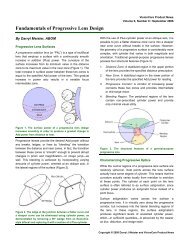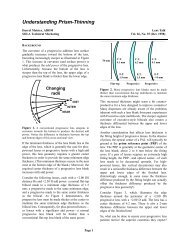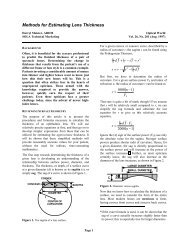OpenOptix ABO Study Guide - Laramy-K Optical
OpenOptix ABO Study Guide - Laramy-K Optical
OpenOptix ABO Study Guide - Laramy-K Optical
You also want an ePaper? Increase the reach of your titles
YUMPU automatically turns print PDFs into web optimized ePapers that Google loves.
UV Coating<br />
An ultra violet coating is added to CR-39 lenses to increase the absorption of harmful UV<br />
rays. This type of coating can easily be done in-house. It is applied by dipping the lens<br />
into a solution for a period of time so that the lens can absorb the UV blocking chemical.<br />
The majority of new lens materials have UV filtering properties inherent in the material.<br />
Mirror Coating<br />
Mirror coatings are highly reflective and are used to reduce the light transmission through<br />
a lens. They are produced in a vacuum process. The chemicals used vary greatly<br />
depending on the color and density of the mirror desired. The coating generally will have<br />
a combination of various metal oxides that when combined will result in the specified<br />
color. Mirror coatings are available as a solid, gradient, double, and triple gradients.<br />
Multifocal Lenses<br />
A multifocal lens can be thought of as two lenses on one. The larger lens is sometimes<br />
referred to as the carrier, while the smaller lens is typically called the segment. The<br />
power of the segment is always a plus and is also commonly referred to as the reading<br />
add. The add power is used to correct presbyopia, compensating for the lack of<br />
accommodation, and allowing the wearer to clearly view objects at near.<br />
The first multifocal lens was created by Benjamin Franklin out of necessity. Mr. Franklin<br />
had a hard time viewing distances and when he had his distance spectacles on he had a<br />
hard time seeing up close. So, around the 1750s Benjamin Franklin had two pairs of<br />
spectacles one for distance and one for near cut in half and placed in one frame together<br />
to create what was referred to as “double spectacles”. Although there is no evidence,<br />
many credit Samuel Pierce as the optician who made the first multifocal lenses for<br />
Benjamin Franklin. The term multifocal in it’s earliest sense was a bifocal however the<br />
term can be used for any lens with multiple focal lengths from trifocals and double D<br />
segments to blended and round segments. There are cemented, fused, and one piece<br />
construction methods for creating multifocal lenses. Cemented multifocals are worked as<br />
two separate lenses with the multifocal section being worked to the equal but opposite<br />
curve of the surface it is being glued to. Cemented lenses used to be constructed with<br />
balsam as the adhesive. However, balsam is susceptible to heat and shock. It also tends to<br />
discolor over time. Although not as common, newer methods include using epoxies to<br />
bond the lenses. One of these cements is Summer <strong>Optical</strong>’s lens bond. Fused<br />
construction is made in glass where sections of higher index glass are fused using heat<br />
into a countersunk corresponding curve in the lens blank. The addition of a fused<br />
multifocal is created by the following relationship:<br />
This document is licensed under the Creative Commons Attribution 3.0 License. 7/30/2009<br />
40









